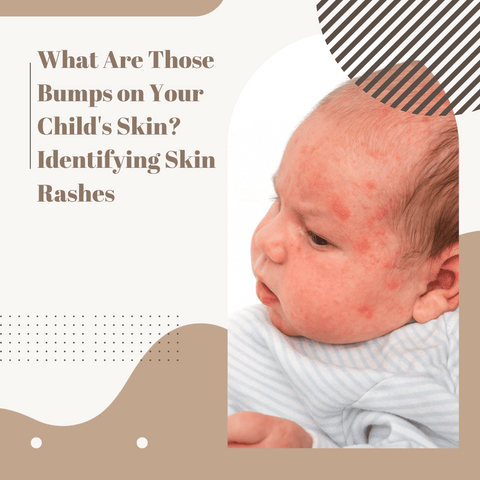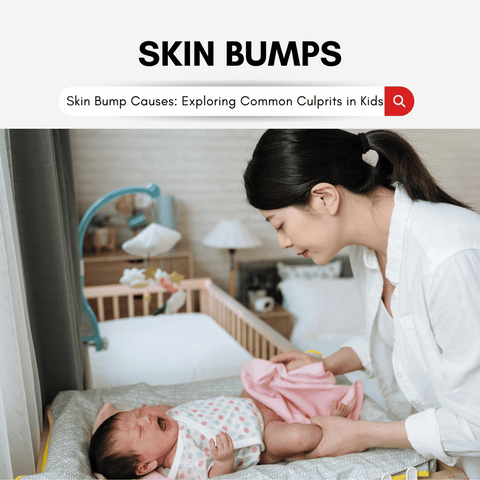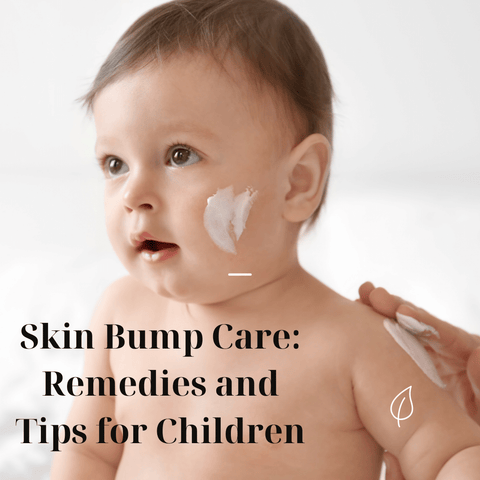Skin pimples in children are not uncommon and are usually not cause for concern. To help demystify skin bumps in children, it's important to understand some of the most frequent causes, such as milia, infant acne, heat rash (miliaria), eczema (atopic dermatitis), contact dermatitis, insect bites or stings, skin infections, and hives (urticaria). While many skin pimples in children are innocuous and disappear on their own, some disorders may necessitate medical care. If you are unsure about the cause or are concerned about your child's skin pimples, it is best to visit a paediatrician or dermatologist for an accurate diagnosis, treatment, and management advice.
What Are Those Bumps on Your Child's Skin? Identifying Skin Rashes

It might be difficult to identify skin rashes on your child because numerous skin disorders can develop as pimples or rashes. Eczema (atopic dermatitis), contact dermatitis, hives (urticaria), heat rash (miliaria), impetigo, chickenpox (varicella), ringworm (tinea), scabies, molluscum contagiosum, and psoriasis are some common skin rashes in children. Because many rashes resemble each other, identifying a skin rash in your child may necessitate the assistance of a healthcare provider. If your kid gets a persistent or severe rash, discomfort, fever, or other troubling symptoms, seek medical help immediately for a proper diagnosis and treatment.
A Closer Look at Common Childhood Skin Conditions
The appearance and severity of common childhood skin conditions can vary. Here are some examples of these conditions:
-
Eczema (Atopic Dermatitis): Eczema frequently manifests as red, itchy, and dry patches of skin. It can arise on the face, scalp, and diaper area of infants. Eczema can affect the elbows, knees, and wrists of older children. Rough, scaly, or bumpy skin may develop.
-
Contact Dermatitis: When the skin reacts to an allergy or irritant, it develops contact dermatitis. At the point of contact, it might produce redness, swelling, and small, irritating bumps or blisters. Poison ivy, certain soaps and lotions, and metals such as nickel are all common triggers.
-
Hives (Urticaria): Hives are itchy, raised welts on the skin that appear and disappear quickly. They might be red or pink with a white or pale centre and vary in size. Allergies, illnesses, and stress can all cause hives.
-
Warts: Human papillomavirus (HPV) causes warts, which are tiny, elevated growths on the skin. Warts on the hands and feet are common in children. They might be rough and bumpy in texture.
-
Molluscum Contagiosum: Molluscum contagiosum is a skin infection caused by a virus that causes small, flesh-colored, or pearly pimples with a central dimple. Bumps are often painless and can appear anywhere on the body.
-
Impetigo: Impetigo is a bacterial skin illness that causes red sores or blisters to leak and build yellow crusts on the skin. It is frequently found around the mouth and nose and is infectious.
-
Ringworm (Tinea): Ringworm is a fungus that causes a circular red rash with elevated margins. It could have a scaly or rough texture. Ringworm can appear anywhere on the body, including the scalp and groyne.
-
Chickenpox (Varicella): Chickenpox is characterised by an itchy rash with red patches that develop into fluid-filled blisters. The rash usually begins on the face and then spreads to the torso, arms, and legs.
-
Scabies: Tiny mites burrow into the skin, creating extreme itching and a red, bumpy rash. Hands, wrists, between the fingers, and body folds are frequently affected.
-
Psoriasis: Psoriasis can manifest as red, scaly skin patches with or without tiny lumps. It frequently affects the scalp, elbows, knees, and lower back in youngsters. Psoriasis is a chronic disease that may necessitate continuing treatment.
It's important to note that the appearance and severity of these skin conditions can vary from child to child. A healthcare physician or dermatologist should give the proper diagnosis and treatment as necessary. If you suspect your child has a skin disease, consult a doctor for an accurate diagnosis and proper treatment.
Uncovering the Mystery: Identifying Skin Bumps in Kids
Identifying skin bumps in children can be difficult because different skin conditions can present with similar symptoms. Here's a guide to help you solve the mystery and identify some common childhood skin bumps:
-
Milia: Description: Tiny, white or yellowish, pinpoint-sized bumps; Location: Usually on the chin, cheeks, and nose; Cause: Skin flakes or clogged sweat glands; Treatment: This condition usually goes away on its own in a few weeks or months.
-
Eczema (Atopic Dermatitis): Description: Red, dry, itchy patches of skin; Location: Most commonly affects the face, scalp, elbows, and knees. Cause: Genetics, allergens, or irritants; Treatment: Emollients, topical steroids, and avoiding triggers.
-
Hives (Urticaria): Description: Raised, red or pink welts with or without itching; Location: Rapidly changing and able to appear anywhere on the body; Causes: infections, stress, allergies, or unidentified triggers; Treatment: antihistamines and identifying and avoiding triggers.
-
Heat Rash (Miliaria): Description: Small red bumps or blisters; Location: Commonly in areas prone to sweating, like the neck, armpits, or diaper area; Cause: Blocked sweat ducts; Treatment: Keep the skin cool and dry.
-
Impetigo: Description: Red sores or blisters that may ooze and form yellow crusts; Location: Frequently located near the mouth and nose; Cause: Bacterial infection (Staphylococcus or Streptococcus); Treatment: Doctor-prescribed antibiotics.
-
Molluscum Contagiosum: Description: Small, flesh-colored or pearly bumps with a central dimple; Location: The body can have it anywhere; Cause: Viral infection (Molluscum contagiosum virus); Treatment: Some cases resolve on their own, but others require medical attention.
-
Warts: Description: Raised, small growths with a rough surface. Location: Commonly on hands and feet; Cause: Human papillomavirus (HPV) infection; Treatment: A healthcare professional can treat the condition, though it might resolve on its own.
-
Psoriasis: Description: Red, scaly patches of skin with or without raised bumps; Location: Usually affects the scalp, elbows, knees, and lower back. Cause: Immune system and genetic factors; Treatment: Emollients, topical steroids, and, in severe cases, systemic medications.
-
Ringworm (Tinea): Description: A circular, red rash with raised edges that can be scaly or bumpy. Location: Can occur on any part of the body, including the body, scalp, or groyne; Cause: a fungus infection; Treatment: Antifungal creams or medications.
When to Consult a Pediatric Dermatologist for Skin Bumps
When you suspect a skin issue or when skin lumps persist, worsen, or cause discomfort in your child, it is best to consult a paediatric dermatologist. Persistent bumps, a worsening condition, unknown bumps, suspected infections, multiple or recurrent bumps, pain, itching, or discomfort, chronic skin conditions, scarring concerns, allergic reactions, skin changes in infants, cosmetic concerns, and complex cases are all reasons to consult a paediatric dermatologist. If you have any worries about your child's skin health or suspect a skin problem that is causing discomfort or concern, you should see a paediatric dermatologist. Early detection and treatment can help manage and alleviate skin issues, ensuring your child's skin's well-being.
Skin Bump Causes: Exploring Common Culprits in Kids

Skin bumps in children can be caused by a number of factors, such as skin diseases, infections, allergies, and environmental factors. Eczema (atopic dermatitis), hives (urticaria), heat rash (miliaria), contact dermatitis, impetigo, ringworm (tinea), molluscum contagiosum, insect bites or stings, warts, chickenpox (varicella), scabies, psoriasis, allergic responses, and birthmarks are some of the most common causes of skin bumps in children. It's vital to note that the look of skin lumps can vary greatly depending on the reason. If you're not sure what's causing your child's skin bumps, or if they're accompanied by other troubling symptoms, see a healthcare practitioner or paediatric dermatologist for an accurate diagnosis and suitable treatment.
Childhood Allergies and Their Impact on Skin Health
Childhood allergies can have a big impact on skin health, causing a variety of skin conditions and reactions. Here are some examples of how allergies can affect a child's skin:
-
Atopic Dermatitis (Eczema): Eczema is a common skin condition in allergic children. Allergic reactions can aggravate or trigger eczema symptoms, resulting in red, itchy, and inflamed skin. Pollen, dust mites, pet dander, and certain foods are common allergens that can aggravate eczema. Managing allergies by avoiding allergens and, if necessary, using allergy medications can help reduce eczema flare-ups.
-
Hives (Urticaria): Allergic reactions, whether caused by foods, medications, insect stings, or other allergens, can cause hives to appear suddenly. Hives are raised, itchy welts on the skin that can vary in size and shape. Identifying and avoiding allergens, as well as using antihistamines, can help relieve hives.
-
Contact Dermatitis: Contact dermatitis can develop when a child with allergies comes into contact with an allergen, such as certain metals, latex, or fragrances in skincare products. It can cause redness, itching, and the formation of small bumps or blisters at the site of contact. Avoiding known allergens and using hypoallergenic products can help prevent contact dermatitis.
-
Food Allergies and Skin Reactions: Some food allergies cause skin reactions such as hives, itching, or a red rash. Peanuts, tree nuts, shellfish, milk, eggs, and soy are all common food allergens. Severe allergic reactions (anaphylaxis) require immediate medical attention.
-
Allergic Reactions to Insect Bites or Stings: Children who are allergic to insects may experience severe skin reactions such as swelling, redness, and hives after being bitten or stung by an insect. Bee and wasp allergies, for example, can result in life-threatening anaphylaxis and require rapid medical intervention.
-
Environmental Allergies and Skin Irritation: Pollen-induced seasonal allergies (hay fever) can cause skin irritation. Allergies can cause skin redness and soreness in these areas if you rub your eyes or nose.
-
Chronic Skin Conditions and Allergies: Allergies may exacerbate existing chronic skin conditions, such as psoriasis or seborrheic dermatitis, leading to increased itching and inflammation. Managing allergies can help children with chronic skin conditions improve their overall skin health.
Irritants and Skin Bumps: Keeping Kids Comfortable
Irritants can contribute significantly to skin pimples and discomfort in youngsters. Choosing hypoallergenic products, avoiding fragrances and dyes, using gentle cleansers, limiting bath time and water temperature, moisturising regularly, choosing soft fabrics, keeping nails trimmed, monitoring allergies, protecting from harsh weather, checking labels, managing allergic reactions promptly, consulting a dermatologist, practising good diaper hygiene, and educating carers are some steps to help keep kids comfortable and minimise skin issues related to irritants. Finding the appropriate skincare routine and products to keep your child's skin comfortable and healthy may take some trial and error. If you have concerns about your child's skin or suspect a skin disease, seek personalised advice and treatment options from a healthcare expert.
Infections and Rashes in Children: Causes and Solutions
Viruses, bacteria, fungi, and environmental triggers can all cause infections and rashes in children. Identification of the cause is critical for effective treatment. Here are some of the most frequent causes and treatments for childhood infections and rashes, including viral infections, bacterial infections, fungal infections, allergic reactions, heat rash, environmental factors, and chronic skin problems. If your child develops an infection or rash, it is critical that you consult a healthcare professional or paediatrician for an accurate diagnosis and suitable treatment. In some situations, the child may require prescription medications or specialised care to adequately treat the disease. Preventive interventions, such as immunisations and basic hygiene practises, can also help reduce the risk of illness.
Skin Bump Care: Remedies and Tips for Children

Skin bumps in children require comfort, promotion of healing, and prevention of further irritation or infection. Here are some home remedies and tips for dealing with skin bumps in children:
-
Keep It Clean: Use a mild soap and lukewarm water to gently clean the affected area. Scrubbing should be avoided because it can irritate the skin.
-
Avoid Scratching: Teach your child not to scratch or pick at the bump, as this can cause infection or scarring. Keep your child's fingernails short to reduce the risk of scratching.
-
Apply Moisturiser: To keep the skin hydrated, use a gentle, fragrance-free moisturiser. Moisturising can help to prevent dry skin and itching.
-
OTC Creams: OTC creams, such as hydrocortisone cream, can help reduce itching and inflammation in some cases. Before using any topical medications on children, consult with a healthcare provider.
-
Use Cool Compresses: For a few minutes, apply a cool, damp cloth to the affected area to relieve itching and discomfort.
-
Oatmeal Baths: An oatmeal bath can relieve itchy skin. Add colloidal oatmeal (available at pharmacies) to your child's bathwater according to package directions.
-
Antihistamines: If your child's skin bump causes itching, an age-appropriate antihistamine may help relieve itching and promote better sleep.
-
Avoid Potential Irritatants: Identify and avoid potential irritants or allergens that may be exacerbating the skin condition. Certain fabrics, soaps, and skincare products may fall into this category.
-
Keep Skin Dry: Keep the area around the skin bump dry. Change wet or sweaty clothing as soon as possible, especially in hot weather.
-
Loose Clothing: To avoid friction and further irritation, dress your child in loose-fitting, breathable clothing made of natural fibres such as cotton.
-
Follow Medical Advice: If the skin bump is caused by a specific condition, such as eczema, psoriasis, or an infection, follow the treatment plan and recommendations of your child's healthcare provider.
-
Look for Infection Symptoms: Look for signs of infection such as increased redness, swelling, warmth, pus, or fever. If you suspect an infection, seek medical attention right away.
-
Consult a Paediatrician or Dermatologist: If the skin bump persists or worsens, or if you have concerns about its appearance or cause, see a paediatrician or consult a dermatologist for a thorough evaluation and appropriate treatment.
Soothing Your Child's Skin: Remedies for Skin Bumps
Gentle care and therapies to ease discomfort and promote healing are used to soothe your child's skin blemishes. Clean the area, apply a cold compress and oatmeal baths, use calamine lotion, moisturise regularly, use over-the-counter creams and antihistamines, keep nails trimmed, avoid irritants, wear loose clothing, consult a healthcare provider, and have patience and consistency. These are some effective remedies for managing skin bumps in children. Keep in mind that each child's skin is different, and the efficiency of therapies may vary. What works for one child may not work for another, so finding the most efficient technique to relieve your child's skin bumps may require some trial and error. Consultation with a healthcare expert can provide helpful advice and ensure your child's skin heals painlessly and properly.
Child Skin Care Essentials: Keeping Their Skin Healthy
Maintaining the health of a child's skin necessitates attention to hygiene, protection, and good skincare. Gentle cleansing, regular moisturising, sun protection, hydration, clothing selection, allergen avoidance, proper diaper hygiene, nail care, managing skin conditions, good nutrition, avoiding overuse of antibacterial products, staying hygienic, consulting a paediatrician or dermatologist, being mindful of environmental factors, and encouraging outdoor play are all important tips to ensure your child's skin stays healthy. You can assist in maintaining your child's skin health and prevent the risk of common skin disorders by following these child skincare essentials. If you have concerns about your child's skin or if skin problems persist, get personalised advice and treatment options from a healthcare expert.
When to Seek Professional Help for Childhood Skin Bumps
While many childhood skin bumps can be treated at home with adequate care, there are some cases where professional assistance from a healthcare provider or paediatric dermatologist is required. Here are some examples of when you should see a doctor about childhood skin bumps:
-
Persistent Bumps: If a skin bump does not improve or disappear within a reasonable time, it is time to seek professional help.
-
Worsening Skin Condition: If the skin condition is worsening, spreading, or causing increasing discomfort, it is critical to seek medical attention.
-
Unknown Cause: If you are unsure about the cause of the skin bump or if it resembles an unusual or unfamiliar rash, consult a doctor.
-
Infection: If the skin bump exhibits signs of infection, such as increased redness, warmth, swelling, pus, or fever, it is critical to seek medical attention as soon as possible.
-
Severe Itching or Discomfort: A healthcare professional can assist if the skin bump is causing severe itching, pain, or discomfort that is not relieved by over-the-counter medications.
-
Skin Conditions: If your child has a history of skin conditions such as eczema, psoriasis, or severe allergies, it is best to consult a dermatologist for proper evaluation and management.
-
New Symptoms: If new symptoms, such as respiratory symptoms, fever, joint pain, or gastrointestinal issues, appear alongside the skin bump, it may indicate an underlying medical condition that requires attention.
-
Cosmetic Issues: If the skin bump has cosmetic implications or is in a highly visible area, such as the face, and is causing your child distress, a dermatologist can discuss treatment options with you.
-
Allergic Reactions: If you suspect an allergic reaction to a specific substance or medication that is causing skin symptoms such as hives, swelling, or blistering, see a healthcare provider or allergist for evaluation and guidance.
-
Recurrent Bumps: If your child has a history of recurring skin issues or develops skin bumps frequently, a healthcare provider can investigate whether there is an underlying condition that requires attention.
-
Scarring Concerns: If the skin bump is at risk of scarring or has already resulted in scarring, a dermatologist can advise you on how to minimise or treat scars.
-
Unusual or Unexplained Skin Changes in Infants: Consult a paediatrician or paediatric dermatologist if you notice unusual or unexplained skin changes, birthmarks, or congenital skin conditions in your newborn or infant.
Preventing and Managing Skin Bumps in Kids: Expert Advice

Skin bump prevention and management in children requires a combination of excellent hygiene practises, protection, and timely treatment when necessary. Here's some expert advise on how to prevent and treat skin pimples in children:
-
Prevention of skin pimples in children requires proper hygiene, clean bedding and clothing, avoiding over-bathing, moisturising, sun protection, allergen identification, and a healthy diet.
-
Managing skin bumps includes cleaning the area, avoiding scratching, cool compresses, topical remedies, avoiding harsh products, nail care, consulting a healthcare provider, treating underlying conditions, preventing infection, and addressing cosmetic concerns.
Keep in mind that each child's skin is different, and what works for one may not work for another. A healthcare expert can offer tailored guidance and treatment alternatives to keep your child's skin healthy and pleasant.
Shielding Your Child from Skin Irritants: Prevention Tips
Protecting your child from skin irritants is essential for maintaining healthy and comfortable skin. Some prevention tips to shield your child from common skin irritants are to choose hypoallergenic products, avoid fragrances and dyes, use gentle cleansers, limit bath time and water temperature, moisturise regularly, choose soft fabrics, keep nails trimmed, monitor allergies, protect from harsh weather, check labels, educate carers, practice good diaper hygiene, avoid overwashing, and consult a dermatologist. Remember that prevention is key to protecting your child's skin from irritants. By following these tips and being mindful of potential triggers, you can help keep your child's skin healthy, comfortable, and irritation-free.
Expert Guidance for Long-Term Skin Health in Children
Long-term skin health in children is critical for their general well-being. Establishing a good skincare routine, sun protection, hydration, a healthy diet, regular moisturising, allergen avoidance, good hygiene practises, consulting a paediatrician or dermatologist, managing skin conditions, avoiding overuse of antibacterial products, nail care, monitoring skin changes, being mindful of environmental factors, and encouraging outdoor play are all expert recommendations to ensure your child's skin remains healthy throughout their development. By following these professional recommendations, you can help keep your child's skin healthy, comfortable, and free of skin problems. Regular skin care practises, as well as early intervention when necessary, will contribute to their skin's long-term health and well-being.
Your Child's Skin, Their Comfort: Taking the Right Steps
Taking proactive steps to maintain your child's skin health and address any issues that may occur is essential to ensuring their skin comfort. Here are some important actions to take to make your child's skin comfortable:
-
Skincare Routine: Create a routine for your child's skincare that includes gentle cleansing and moisturising. Choose products that are suitable for their skin type and are free of irritants.
-
Sun Protection: Cover your child's skin with sunscreen with an SPF of 30 or higher, and when they are outside, make sure they are wearing protective clothing, sunglasses, and a wide-brimmed hat.
-
Hydration: Make sure your child drinks plenty of water to stay hydrated. Hydration is essential for maintaining healthy and comfortable skin.
-
Healthy Diet: Promote a well-balanced diet rich in fruits, vegetables, and whole grains. Omega-3 fatty acids from foods such as fish can benefit skin health.
-
Moisturise on a regular basis: After bathing, apply a fragrance-free moisturiser to your child's skin to lock in moisture and prevent dryness.
-
Avoid Potential Allergens: Recognise and avoid potential allergens or irritants that may cause skin reactions, such as specific fabrics, soaps, or skincare products.
-
Good Hygiene Practises: Teach your child proper handwashing and hygiene practises to prevent the spread of germs that can cause skin infections.
-
Nail Care: Keep your child's nails short to avoid scratching, which can aggravate skin conditions or cause irritation.
-
Check for Skin Changes: Check your child's skin on a regular basis for any changes, unusual rashes, or abnormalities. Consult a healthcare provider as soon as possible if you have any concerns.
-
Consult a Paediatrician or Dermatologist: If your child develops persistent skin problems, see a paediatrician or dermatologist for an accurate diagnosis and treatment plan.
-
Manage Skin Conditions: If your child has eczema or psoriasis, follow the treatment plan prescribed by a healthcare provider or dermatologist.
-
Avoid Overuse of Antibacterial Products: Antibacterial soaps and hand sanitizers can strip the skin of beneficial bacteria and natural oils.
-
Consider Environmental Factors: Environmental factors such as pollution can have an impact on skin health. If necessary, use air purifiers, particularly in urban areas.
-
Encourage Outdoor Play: Encourage your child to participate in outdoor activities because physical activity and fresh air are beneficial to overall skin health.
By following these steps, you can prioritise your child's skin comfort and ensure they have healthy, comfortable skin. Regular skincare practises and vigilance in addressing any skin issues will contribute to their overall well-being and comfort.









































